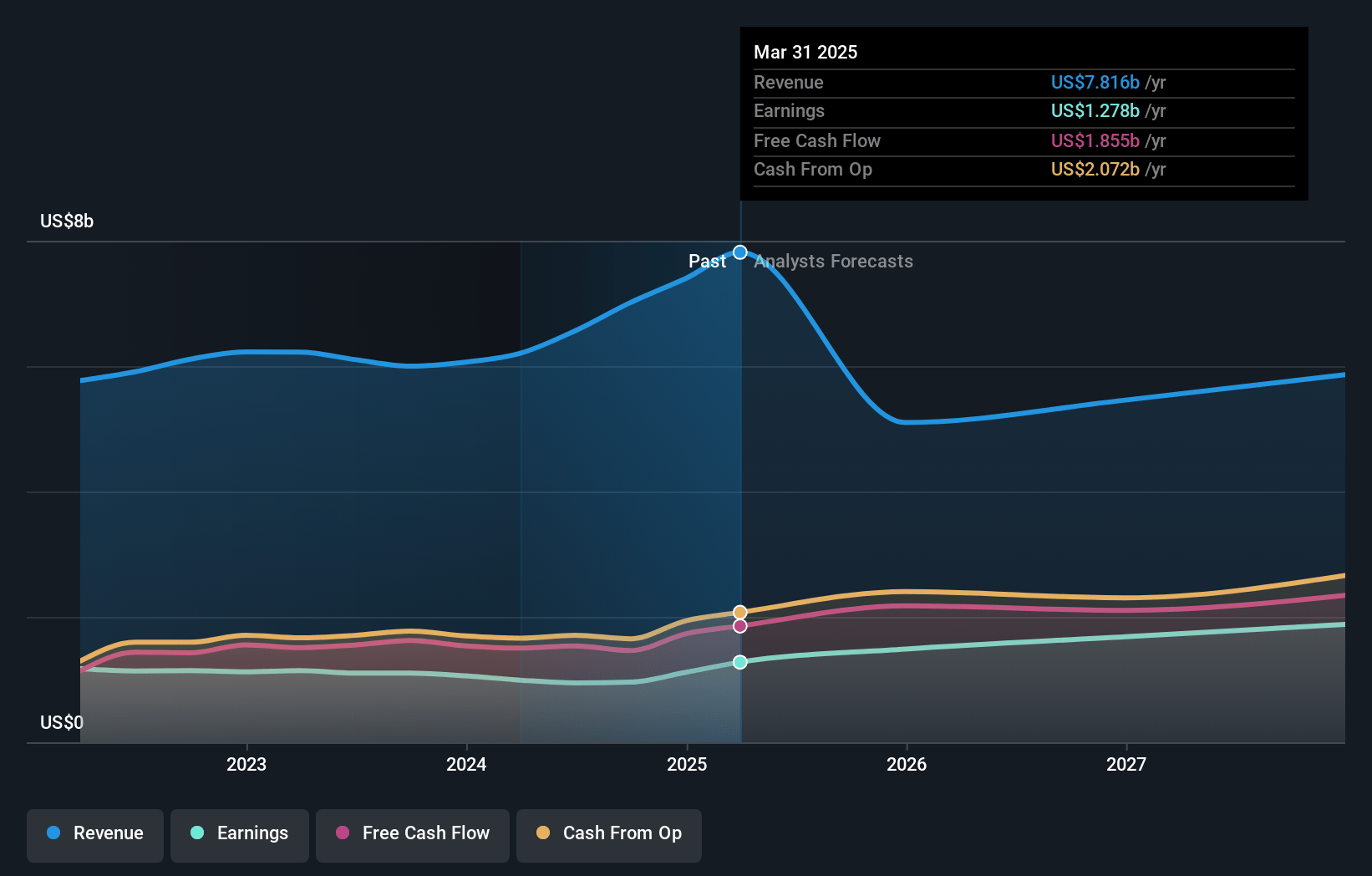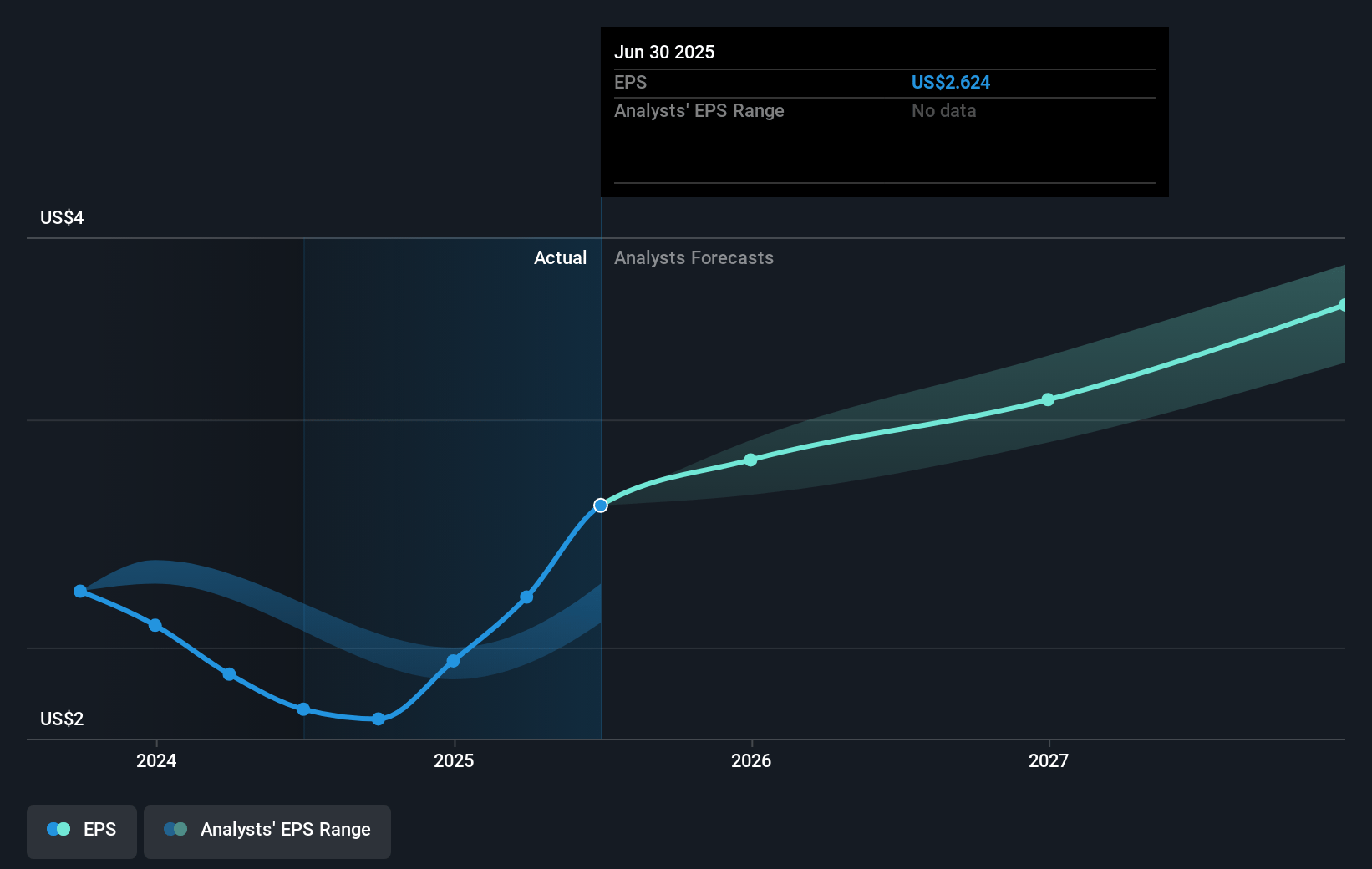Key Takeaways
- The strategic integration and market traction are driving revenue growth and improving margins through efficiencies and new opportunities.
- Expansion into Europe and focus on digital assets enhance growth potential, signaling increased future earnings and market presence.
- Reliance on Tier 1 and Tier 2 banks, regulatory uncertainties, market share loss, and client preferences threaten Nasdaq's revenue and margin growth.
Catalysts
About Nasdaq- Operates as a technology company that serves capital markets and other industries worldwide.
- The integration of AxiomSL and Calypso into Nasdaq's Financial Technology division has accelerated the company's platform evolution, enhancing operational efficiency and opening up cross-sell opportunities with global financial institutions. This is expected to drive revenue growth and improve net margins through economies of scale.
- Nasdaq's significant traction with new client wins, upsells, and cross-sells demonstrates growing market demand for its solutions in Capital Markets, Regulatory, and Financial Crime Management Technology. This is likely to positively impact revenue and earnings growth over time.
- The expansion into the European market with Nasdaq Verafin indicates a strategic international growth initiative, aiming to tap into new client bases and regulatory needs, which could increase ARR and long-term revenue.
- Continued innovation and product development, including AI-powered solutions, are expected to improve product offerings, enhancing client retention and expanding market share. This is likely to lead to higher revenue and improved earnings.
- The strategic focus on digital assets and potential regulatory clarity around cryptocurrencies could unlock new revenue streams and enhance Nasdaq’s position in the market, potentially increasing future earnings and overall company value.
Nasdaq Future Earnings and Revenue Growth
Assumptions
How have these above catalysts been quantified?- Analysts are assuming Nasdaq's revenue will decrease by 8.1% annually over the next 3 years.
- Analysts assume that profit margins will increase from 15.1% today to 30.6% in 3 years time.
- Analysts expect earnings to reach $1.8 billion (and earnings per share of $3.21) by about April 2028, up from $1.1 billion today. The analysts are largely in agreement about this estimate.
- In order for the above numbers to justify the analysts price target, the company would need to trade at a PE ratio of 33.6x on those 2028 earnings, down from 36.9x today. This future PE is greater than the current PE for the US Capital Markets industry at 24.2x.
- Analysts expect the number of shares outstanding to decline by 0.24% per year for the next 3 years.
- To value all of this in today's terms, we will use a discount rate of 7.59%, as per the Simply Wall St company report.
Nasdaq Future Earnings Per Share Growth
Risks
What could happen that would invalidate this narrative?- A potential slowdown in the financial crime management growth due to a reliance on capturing Tier 1 and Tier 2 banks, which may not materialize as quickly as anticipated, could impact earnings expectations for this segment.
- The possibility of deregulatory moves under the current political administration could reduce demand for regulatory compliance solutions, which may reduce revenue growth for the Regulatory Technology division.
- Despite strong recent revenue numbers, the lingering impacts of market share loss in Market Services and potential future competition could erode net margins over time.
- A high level of delisting activity and elongated corporate buying cycles could negatively affect the Workflow and Insights segment, putting pressure on the revenue growth from corporate solutions.
- Any disruptions in cloud adoption or changes in client preferences for in-house solutions could slow the adoption of Nasdaq’s cloud-based offerings, impacting ARR growth projections significantly.
Valuation
How have all the factors above been brought together to estimate a fair value?- The analysts have a consensus price target of $83.167 for Nasdaq based on their expectations of its future earnings growth, profit margins and other risk factors. However, there is a degree of disagreement amongst analysts, with the most bullish reporting a price target of $105.0, and the most bearish reporting a price target of just $68.0.
- In order for you to agree with the analyst's consensus, you'd need to believe that by 2028, revenues will be $5.8 billion, earnings will come to $1.8 billion, and it would be trading on a PE ratio of 33.6x, assuming you use a discount rate of 7.6%.
- Given the current share price of $71.69, the analyst price target of $83.17 is 13.8% higher.
- We always encourage you to reach your own conclusions though. So sense check these analyst numbers against your own assumptions and expectations based on your understanding of the business and what you believe is probable.
How well do narratives help inform your perspective?
Disclaimer
Warren A.I. is a tool utilizing a Large Language Model (LLM) that ingests data on consensus price targets, forecasted revenue and earnings figures, as well as the transcripts of earnings calls to produce qualitative analysis. The narratives produced by Warren A.I. are general in nature and are based solely on analyst data and publicly-available material published by the respective companies. These scenarios are not indicative of the company's future performance and are exploratory in nature. Simply Wall St has no position in the company(s) mentioned. Simply Wall St may provide the securities issuer or related entities with website advertising services for a fee, on an arm's length basis. These relationships have no impact on the way we conduct our business, the content we host, or how our content is served to users. The price targets and estimates used are consensus data, and do not constitute a recommendation to buy or sell any stock, and they do not take account of your objectives, or your financial situation. Note that Warren A.I.'s analysis may not factor in the latest price-sensitive company announcements or qualitative material.




